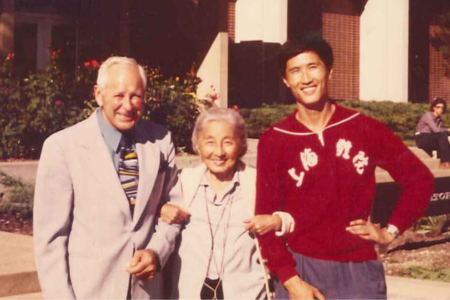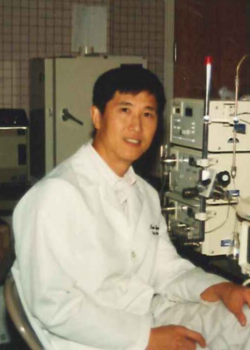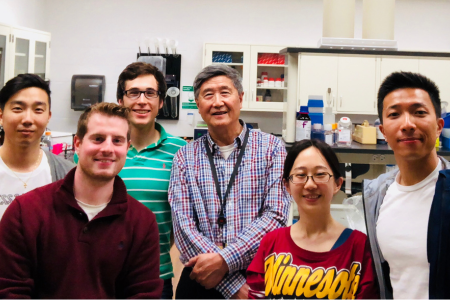You see the teacher in Li Li Ji, Ph.D., FACSM, almost immediately. He has a gentle presence and soft tone, but there is also a glint in his eye that suggests the unending and infectious excitement he has for his field. Such a thing is vital in an instructor. Vital too in a researcher who wants to work collaboratively. His enthusiasm draws you in. His cadence begins to quicken. You are compelled not only by his answers but by the questions he believes said answers in turn uncover.
This is the heart of the scientific enterprise, of course. But its soul is a character like Dr. Ji.
As we get to talking, I’m charmed to discover that in his youth he was the captain of the City of Shanghai University All Star Basketball Team for the 1975/76 season and became head coach of one of the three Shanghai Workers Union Basketball Teams in ’76, the same year he graduated with a Bachelor of Science from East China Normal University. At ACSM, it’s always a pleasant surprise to encounter the accomplished athlete at the core of the accomplished researcher.
 But being highly skilled in multiple fields can be a bit of a mixed blessing: Fundamentally, Ji had a choice to make. He could continue on as a basketball coach, or he could pursue a career as a scientist. Multiple opportunities had presented themselves — he’d been chosen to work as a translator for the first NCAA delegation to China, led by famed BYU basketball coach Frank Arnold, as post Ping-Pong Diplomacy relations between the PRC and U.S. continued to thaw. He and Arnold got along well. They kept up a correspondence after Arnold returned Stateside.
But being highly skilled in multiple fields can be a bit of a mixed blessing: Fundamentally, Ji had a choice to make. He could continue on as a basketball coach, or he could pursue a career as a scientist. Multiple opportunities had presented themselves — he’d been chosen to work as a translator for the first NCAA delegation to China, led by famed BYU basketball coach Frank Arnold, as post Ping-Pong Diplomacy relations between the PRC and U.S. continued to thaw. He and Arnold got along well. They kept up a correspondence after Arnold returned Stateside.
“He was offering me to be a Cougar,” Ji says ruefully. “And offered me an assistant basketball coach position. It was a big decision, but I decided I would pursue science.”
Instead, Ji enrolled as a master’s student at the University of Wisconsin-Madison at the end of 1979. Thus, his affiliation with ACSM began early: His master’s adviser was Henry Montoye, Ph.D., FACSM, (ACSM president, 1956) and his first major ACSM experience was attending the 1981 annual meeting.
“The department took a van, and we drove all the way to Miami Beach,” he says. “It was, like, two whole days.”
He began attending ACSM meetings regularly from them on.
The effects of exercise and nutrition on oxidative stress
Next, Ji pursued doctoral studies under Henry Lardy and Francis Nagle, earning his Ph.D. in 1985. During that time, he worked with Lardy on a rat model studying the effects of beta blockers on training adaptation, eventually contributing a groundbreaking study showing that since non-selective betablockers downregulate key muscle enzymes, they actually prevent the body from adapting to exercise.
 The following two years saw Ji working as a postdoc at Madison’s Institute for Enzyme Research, cementing a move into more basic science. By 1990, he was an ACSM fellow.
The following two years saw Ji working as a postdoc at Madison’s Institute for Enzyme Research, cementing a move into more basic science. By 1990, he was an ACSM fellow.
No surprise, then, that Ji now specializes in the interactions among enzymatic, free radicals and antioxidant responses to exercise. At this point we take a deeper dive into how he became interested the subject:
“In the early to mid-eighties there were serval groundbreaking papers from UC Berkely and the West Coast,” he says. “They used electron resonance to measure free radicals in situ. And with exercise, they could show that free radicals are generated.”
He was inspired, but he had to take a different tack, given equipment limitations.
“Of course, at that time I didn’t have access to (electron paramagnetic resonance). So, we studied almost every antioxidant enzyme in the body and found that these antioxidants are activated by exercise. And when rats are chronically trained, their protection is also elevated. So trained animals are less susceptible to the harmful effects of free radicals.”
By the 1990s, antioxidant supplementation was all the rage. Ji recalls that people were constantly talking about it at conferences. But was it really that simple?
“We didn’t know at that time that there are some side effects,” he says. “We didn’t detect that you also knock down some of the training repose.” He smiles. “It’s like, you know, people feeling an elephant. To some it’s a wall; to someone else it’s a post.”
Finally, he recalls, a team in Spain working with Tour de France cyclists gave riders high doses of vitamin E, attempting to show a benefit.
“But actually, what they found was a lot of training effects were attenuated.”
As usual, the body’s systems appeared more complex the more you studied them.
“Then we realized that actually, the true free radicals do not stay in the body very long. The ones we often use interchangeably are the reactive oxygen species (ROS) and some are usually more stable, like hydrogen peroxide and nitric oxide. But the real free radicals, they exist for a split second — you know, 10 to the minus seven or less. But the stable species like hydrogen peroxide, they usually serve as a signaling molecule.”
Thus, the ROS contemporary researchers were attenuating with antioxidants were actually necessary for recovery, among other purposes.
Another of Ji’s endeavors included looking into the effects of sedentary lifestyle on muscle, particularly determining which enzymes turned on and off while the muscle was immobile. He and his fellow authors used a rat model, stopped contraction of the muscle, and found that it took only two weeks for muscle mass to drop 25-30%. They wanted to know how.
“When the muscles are immobilized, most of the loss of weight is loss of protein. And how does protein degrade during that period? We tried to elucidate the pathways,” he says. “Luckily, some of the basic scientists had laid down the groundwork to show some of the key elements of muscle degradation. We applied that concept to find several important enzymes that cause muscle degradation.”
But upstream of those enzymes was PGC-1α, a transcription coactivator (essentially, a protein that increases or decreases the expression of various parts of an organism’s genetic code). The research led to a series of papers, including “PGC-1α overexpression via local transfection attenuates mitophagy pathway in muscle disuse atrophy” (2013), “PGC-1α overexpression via local transfection attenuates mitophagy pathway in muscle disuse atrophy” (2015) and “Muscle immobilization activates mitophagy and disrupts mitochondrial dynamics in mice” (2016). Eventually, Ji and his colleagues were able to use E. coli to produce PGC-1α, introduce it in vivo, and observe the resultant attenuation of both muscle breakdown and oxidative stress.
This is just a small piece of Ji’s output over the years, and I’ve included it mostly to provide the flavor of his research rather than as a truly representative example. His efforts have been both too broad and too specific to accurately describe in such a short profile. He’s published more than 175 papers and 23 book chapters, garnering nearly 23,000 citations. Twenty-four of his papers have been cited more than 300 times. He’s also written two books and acted as editor for a third (the latter two forthcoming this year).
To put a bow to it all, if possible, would be to say that he is interested in the effects of exercise and nutrition on oxidative stress. Far too simplistic a summation, but close to adequate for a 10,000 ft. view.
What's next?
 As for his upcoming work, Ji says he now spends much of his time reviewing others’ work, whether individually or as a member of various editorial and advisory boards. (He serves or has served on 15.) One sees Ji as a sort of elder statesman in the field, someone whose opinion is justly valued and sought after. I return to my original thought that Ji has the air of a teacher. Such personalities have staying power, and their insights ripple out into their fields sometimes so naturally and expectedly that we sometimes forget how profound they are.
As for his upcoming work, Ji says he now spends much of his time reviewing others’ work, whether individually or as a member of various editorial and advisory boards. (He serves or has served on 15.) One sees Ji as a sort of elder statesman in the field, someone whose opinion is justly valued and sought after. I return to my original thought that Ji has the air of a teacher. Such personalities have staying power, and their insights ripple out into their fields sometimes so naturally and expectedly that we sometimes forget how profound they are.
The most important note on Ji’s itinerary, though, was a trip to Hungary immediately prior to the 2023 ACSM Annual Meeting & World Congresses. By the time Ji accepts his Citation Award, he’ll have accepted an honorary causa doctorate from Hungary’s University of Sport Science, with such previous recipients as John Holloszy and Juan Antonio Samaranch. This will be in addition to two honorary professorships he already holds from prestigious universities in China.
Scott Powers, Ph.D., FACSM, noted in his letter nominating Ji for an ACSM Citation Award that “Without question, his research has greatly improved our understanding of the antioxidant systems in cardiac and skeletal muscle in both health and disease. In my view, Dr. Ji’s research and professional accomplishments are consistent with the highest expectations of an individual receiving the ACSM Citation Award for scholarly work.”
But Ji is humble. He simply says, “I’m the person to receive the award, but the people behind me are the ones who really deserve it. My postdocs and students.”
“Without question, [Dr. Ji’s] research has greatly improved our understanding of the antioxidant systems in cardiac and skeletal muscle in both health and disease. In my view, Dr. Ji’s research and professional accomplishments are consistent with the highest expectations of an individual receiving the ACSM Citation Award for scholarly work.”
- Citation Award nominator Scott Powers, Ph.D., FACSM